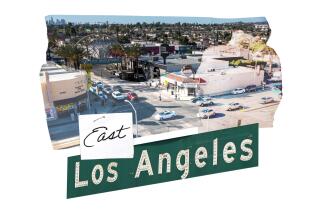Eastsiders Think Valley’s Grass Is Already Greener
To many residents of Los Angeles neighborhoods east of downtown, the San Fernando Valley already is Camelot, a proposed name for a new municipality north of Mulholland Drive. So is Hollywood.
“I wish I could afford to live in those communities,” said Martha Garcia, a 32-year-old mother in El Sereno who was bused from the Eastside to attend school in the Valley. “They have a right to improve their communities, but I think they’re already nice, especially compared to here.”
Eastside sympathy exists for Valley and Hollywood secession bids on the Nov. 5 ballot. But for those living in places such as El Sereno, Boyle Heights and Lincoln Heights, their needs come first.
“The city ignores our community,” said Hugo Garcia (no relation to Martha Garcia), 47, an L.A. native who will vote against secession. “We have to look after ourselves because the city doesn’t do a good job.”
The Eastside is home to mostly Latinos, a group viewed by both sides in the breakaway campaign as a swing vote. Secessionists claim that splitting Los Angeles into three cities and bringing government closer to neighborhoods would give Latinos more clout in each of the municipalities. Opponents, however, say secession could cause financial strains that would rob Latinos of essential services.
Many Eastsiders said they hadn’t heard of the cityhood initiatives. Nor is the breakup campaign a priority, they added.
“[We] struggle for basic services,” Hugo Garcia said. “And respect.”
Consider the El Sereno Recreation Center, he said. The park’s tidy patch of grass for baseball and football games is tiny compared with the open spaces at other city parks, including those in the Valley. The sprawling Van Nuys-Sherman Oaks Park, for example, boasts separate fields for baseball, Little League and soccer, as well as basketball courts and picnic areas. Parents say El Sereno’s park is so cramped that children get hurt bumping into each other.
Because there are few benches at the park, Hugo Garcia brought a blue portable chair so he could watch his teenage daughter jump, flip and clap during a cheering squad practice on a hot autumn night. He leaped out of the chair in a huff and pointed to the sloping dirt parking lot.
“This is what I mean,” he said. “We’ve been trying for years--for years--to get the city to pave it.”
The untamed lot is on a long list of problems cited by Eastsiders. Graffiti defaces stores, homes and bus stops. Tattered sofas and soiled mattresses line sidewalks. Gangs run rampant. Poverty deflates dreams.
It’s also a community where families stay for generations, in charming bungalows on tree-lined streets graced with children’s laughter. Statues of the Virgin Mary adorn lawns. Neighbors not only know each other, they often celebrate life’s milestones together, as if they were an extended family.
For years, Valley secessionists have complained that the city allocates funds to impoverished neighborhoods on the Eastside and in South Los Angeles at the expense of the blighted northeast Valley, one of the poorest communities in L.A.
Now they argue that a smaller Los Angeles would benefit needy neighborhoods across the city, by making government smaller and more accountable.
“People could take better control of City Hall,” said Richard Close, a Sherman Oaks homeowner and chairman of Valley VOTE, the group spearheading Valley secession. “They’d have more contact with council members.”
Secessionists plan to hold forums in East Los Angeles, but Close said the campaign’s emphasis will be on communities with high voter turnout. Traditionally, Eastside turnout is lower than in other parts of L.A., city officials said.
The secession measures need citywide majorities to win.
Breakaway proponents expressed optimism that all of L.A.’s Latino communities will show their support on election day, especially since Latinos are running for council offices in the proposed cities. Lt. Gov. Cruz Bustamante’s endorsement of an independent Hollywood also helped, they said.
“East Los Angeles understands,” said Gene La Pietra, founder of the Hollywood secession movement.
Latinos make up 49% of Hollywood’s residents and would wield more power if the area became its own city, La Pietra said. “That translates into the Eastside’s support.”
The Eastside has one staunch breakup supporter: Don Levy, 65, a white lifelong L.A. resident who lives in an arts colony complex in Lincoln Heights. The Web designer said the city’s bureaucrats ignore the housing and business needs of the artistic community.
“I don’t believe City Hall can be fixed,” Levy said. “I have yet to be convinced that [officials] can get rid of their old habits.”
Other Eastsiders, however, fear the secession movement is being led by wealthy whites who have no interest in less-affluent neighborhoods.
“[Secessionists] say it has nothing to do with race or class,” said Martha Garcia, who will vote against secession. “But I think it does. A lot of us do.”
Garcia’s recent move to El Sereno was a big step up from the “ghetto lifestyle” she and her two children endured while living near Staples Center.
But already the L.A. native dreams of leaving the Eastside, perhaps for the nearby San Gabriel Valley.
“The city doesn’t care about us,” Garcia said. “I don’t like this area anymore.”
Maria Maldonado, relaxing with friends at El Sereno park on a Thursday evening, also wants out of the Eastside. She’s 52 and has lived in the area since she was born.
“Just the fact that the city hasn’t paved the parking lot shows that they don’t care as much here as they do in, say, the Valley.”
Maldonado wondered why anyone in her community would vote for secession. She believes a split would leave less city money for the Eastside.
“It’s just going to hurt us more,” Maldonado said.
More to Read
Sign up for Essential California
The most important California stories and recommendations in your inbox every morning.
You may occasionally receive promotional content from the Los Angeles Times.










